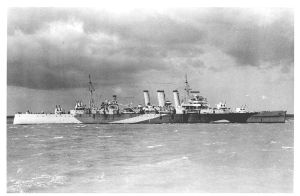HMS Norfolk (78)
This article includes a list of references, related reading, or external links, but its sources remain unclear because it lacks inline citations. (June 2008) |
 Norfolk in wartime camouflage. She still retains X turret, therefore this photo is pre-1944
| |
| History | |
|---|---|
| Name | HMS Norfolk |
| Builder | Fairfield Shipbuilding & Engineering Co. Ltd, Govan |
| Laid down | 8 July 1927 |
| Launched | 12 December 1928 |
| Commissioned | 30 April 1930 |
| Fate | Sold for scrapping on 3 January 1950 |
| General characteristics | |
| Displacement | list error: <br /> list (help) 10,035 tons standard 13,420 tons full load |
| Length | 610 ft (190 m) |
| Beam | 66 ft (20 m) |
| Draught | 16 ft (4.9 m) |
| Propulsion | list error: <br /> list (help) Parsons geared or Brown Curtis steam turbines 4 shafts 8 boilers 80,000 shp (60 MN) |
| Speed | 31.5 knots (58 km/h) |
| Range | 12,000 nautical miles (22,000 km) at 12 knots (22 km/h) |
| Complement | 710 private ship, 819 war |
| Armament | list error: mixed text and list (help)
|
| Aircraft carried | Two Walrus aircraft (operated by 700 Naval Air Squadron) |
HMS Norfolk (78) was a County-class heavy cruiser of the Royal Navy. She was laid down in July 1927 at Govan by Fairfield Shipbuilding & Engineering Co. Ltd and launched on 12 December 1928. She was commissioned on 30 April 1930. In September 1931, Norfolk was part of a mutiny that later became known as the Invergordon Mutiny. She later served with the Home Fleet until 1932 and then went to the America and West Indies Station between 1932 and 1934. From 1935 to 1939 she served on the East Indies Station before coming home to refit in 1939, being still in dockyard hands when war was declared.

At the outbreak of war in 1939, Norfolk deployed with the 18th Cruiser Squadron of the Home Fleet, and was involved in the chase for the German battlecruisers (or light battleships) Gneisenau and Scharnhorst, along with the Admiral Scheer. She was soon receiving numerous repairs for damage that she had received, not to mention vital modifications to the ship. Her first repairs were carried out in Belfast, after a near-miss by a torpedo from the German submarine U-47, the submarine responsible for sinking the Royal Navy battleship Royal Oak.
Shortly afterwards, bomb damage that she had received from a heavy air raid, forced her into yet another repair, this time on the Clyde. After these repairs had been completed, Norfolk proceeded to the Tyne Shipyard for a new addition to her equipment - a radar set.
In December 1940 she was ordered to the South Atlantic on trade protection duties, operating from Freetown as part of Force K and also tasked with the hunt for the Admiral Scheer and, in January 1941, the raider Kormoran. In February she escorted Atlantic troop convoys, but by May she had returned to Icelandic waters. Norfolk was the second ship to sight the Bismarck. She continued to dog the German battleship and was part of the force with Rodney and King George V that sank her. From September onwards, she was employed as an escort for the arduous Arctic Convoys. Norfolk was part of the cruiser covering force of convoy JW55B, when it engaged Scharnhorst, on 26 December 1943. She scored three hits on the German vessel which withdrew and was later caught and sunk by the Duke of York and her escorts.

She sustained damage in that confrontation, which was subsequently repaired on the Tyne, which prevented her from being involved in the historic D-day landings. When the war came to a close, Norfolk left Plymouth for a much needed refit at Malta, after transporting the Norwegian Royal family back to Oslo after their 5-year exile in London. This was followed by service in the East Indies as the flagship of the Commander-In-Chief East Indies Station.
In 1949, Norfolk returned to the UK and was placed in Reserve. She was sold to BISCO for scrapping on 3 January 1950. On 14 February 1950, she proceeded to Newport, arriving on 19 February, to be broken up after a long and proud service of 22 years, in which she gained the Norfolk lineage the majority of its battle honours, including its last.
Battle honours
Atlantic 1941, Bismarck 1941, Arctic 1941–1943, North Africa 1942, North Cape 1943, Norway 1945
References
- Colledge, J. J.; Warlow, Ben (2006) [1969]. Ships of the Royal Navy: The Complete Record of all Fighting Ships of the Royal Navy (Rev. ed.). London: Chatham Publishing. ISBN 978-1-86176-281-8.
- British and Empire Warships of the Second World War, H T Lenton, Greenhill Books, ISBN 1-85367-277-7
- Conway's All the World's Fighting Ships, 1922-1946, Ed. Robert Gardiner, Naval Institute Press, ISBN 0-87021-913-8
- HMS Norfolk at U-boat.net
- Cruisers of World War II
